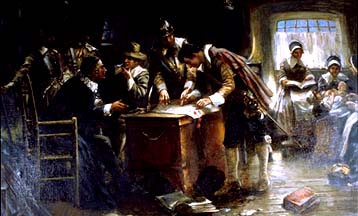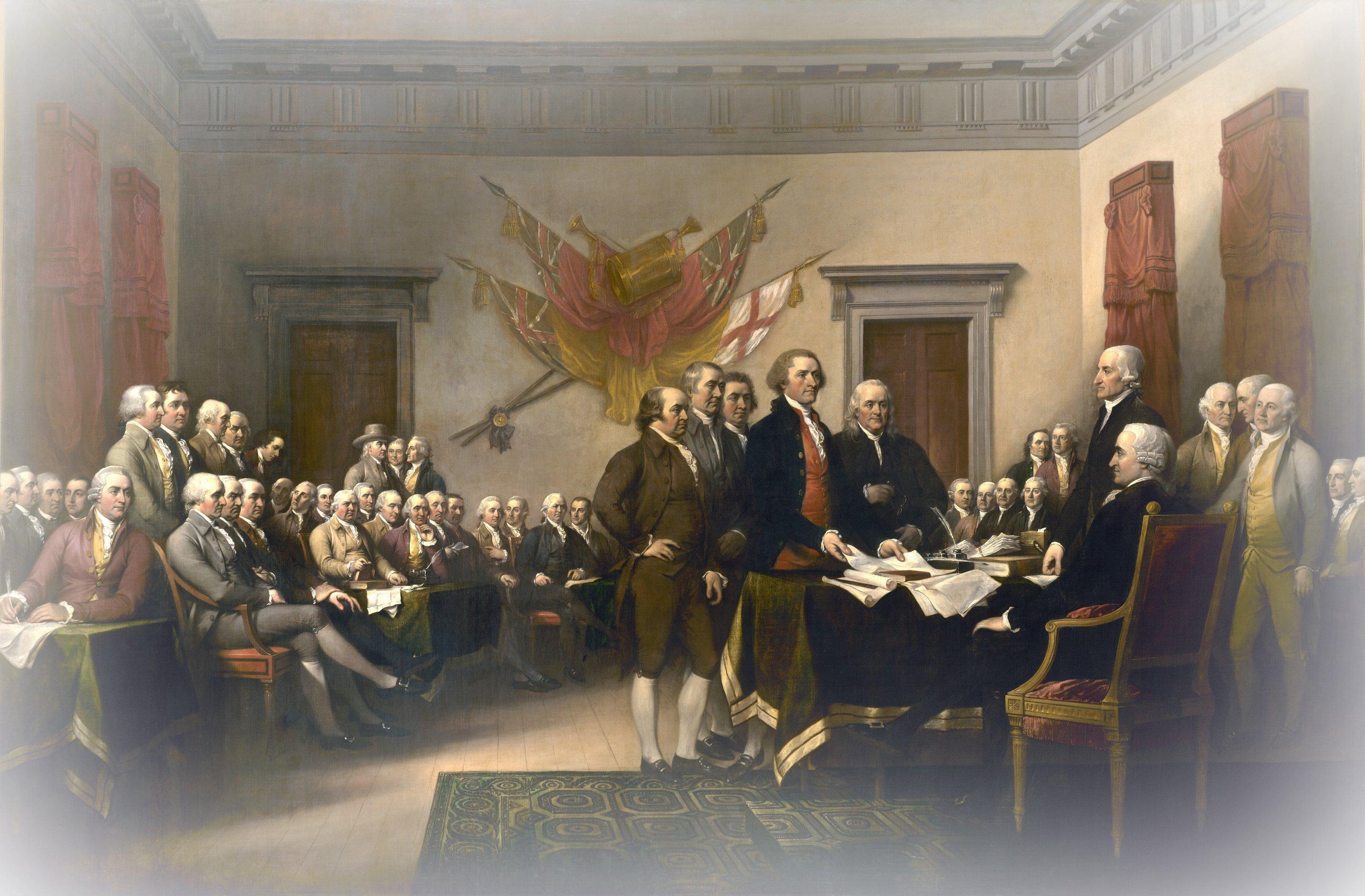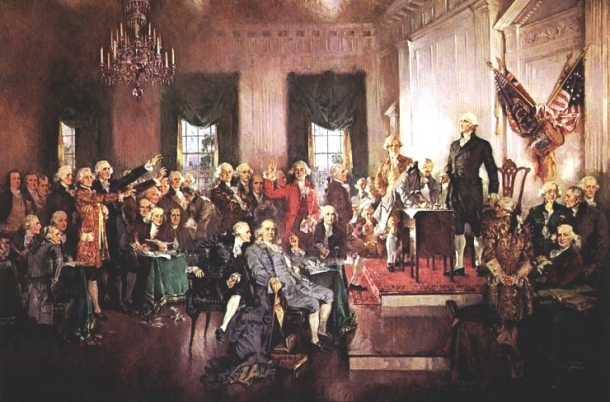Revolution!
– Founding I
In this course
we will examine Providence at work in the founding of America, from Christopher
Columbus and the settlements at Jamestown and Plymouth, to the convention at
Philadelphia in 1787 and beyond. Many of
those involved in these events felt inspired to move forward the designs of
Providence – indeed, some saw the establishment of America as the fulfillment
of Biblical prophecy, a land from which the principles of liberty and pure
religion could radiate to illumine a darkened world.
We have before us today an even greater challenge (and opportunity!) than our Founders had. I believe our young men and women will rise to the challenge as they learn not just metaphorically to stand on the shoulders of great ones, but also, perhaps even more importantly, literally to stand with those great ones as God helps them fulfill their missions.
Week 1: Introduction. God’s purpose in inspiring Columbus,
Importance of America’s Founding, Constitutional principles, Foundings in the
historical cycles, Concord Minutemen, Trenton Continentals, Princeton Extra-milers.
Week 2: New Colonies. Jamestown, Puritans & Pilgrims, Biblical
foundations (A new Israel).
Please study about the settlements of Jamestown and Plymouth, and read the *Mayflower Compact and Watertown Covenant.

Additional
reading: *Virginia Articles, Laws, and Orders; *Fundamental Orders of Connecticut; *Massachusetts Body of Liberties;
John Winthrop, *”Little Speech on Liberty”; New
England Confederation.
Week 3: English History and Strained
Ties. Magna Charta, Stuarts, English
Civil War, Glorious Revolution, English Bill of Rights, Act of Union, John
Wesley and the Great Awakening, Hohenzollern Kings, French and Indian War,
Taxation Without representation.
Please
read Mary Mostert, Banner of Liberty
Book I, chapters 1-4; John Dickinson, “Letters from a Farmer in Pennsylvania,”
Letters *V, VII, and *IX.
Additional
reading: Charles Dickens, A Child’s History of England chapters 14
and 32-37 (or equivalent history of England for the subjects listed above); *Magna Charta, 1215, *Petition of Rights, 1628; *The English Bill of Rights, 1689; *Resolutions of the House of Burgesses,
1765; *Declarations of the Stamp Act
Congress, 1765; Nathaniel Hawthorne, “The Gray Champion” in Twice-Told Tales.
Week 4: War Actually Begun. Boston Massacre, Boston Tea Party,
Intolerable Acts, First Continental Congress, Lexington and Concord, Bunker
Hill, a new Commander-in-chief, Ticonderoga, guns on Dorchester Heights, Quebec. John
Adams defends British soldiers, Sam Adams and the Sons of Liberty, Nathanael
Greene, Henry Knox.
Please
read Mostert, Book I, 5-13, 15.
Additional
reading: Silas Downer, *“A Discourse at the Dedication of the Tree of
Liberty”; *Declaration and Resolves of
the First Continental Congress, 1774; Patrick Henry, “Give me Liberty or
Give Me Death” speech.
Week 5: A New Nation. The Declaration of Independence;
Providence at work at Long Island, Trenton, and Princeton.
Please
read Mostert 14, 16-28
Additional reading: Thomas Paine, *“Common Sense”, *Declaration of Independence; Paine, “Crisis 1”.

Week 6: Recognition + A Real Army = Victory. Adams and Franklin in Paris, von Steuben at Valley Forge, de Kalb dies at Camden, Benedict Arnold – Pride cometh before the fall, Daniel Morgan halts British success in the South, the French fleet arrives, Cornwallis surrenders at Yorktown.
Please
read Mostert II, 1, 3-10.
Additional
reading: *The Articles of Confederation; John Adams, *“Thoughts on
Government”; *Northwest Ordinance.
Week 7: The Greatest Man
Who Ever Lived? Washington eschews
taking power, a nation of laws is formed.
The Newburgh Conspiracy, Articles of Confederation go into effect,
Washington resigns his commission, Shays rebellion, Washington urges reforms,
convention at Philadelphia.
Please
read Mostert II, 2, 11-15.
Additional
reading: Federalist *10, 15, 16, 22,
*51
Week 8: Article
I. The Legislature.
Please
read Mostert II, 15-19; Constitution,
Article I.
Additional reading: Federalist 55, 58, 62, 64.
Week 9: Article II. The Executive.
Please
read Mostert II, 20-22; Constitution,
Article II
Additional
reading: Federalist 68, 70, 73, 74, 75.
Week 10: Articles III-VI. The Judiciary, etc.
Please
read Mostert, II, 23-26; Constitution, Articles III-VI
Additional reading: Federalist *78, 82; Brutus, “Essay XI”.

Week 11: Activity. Constitution wrap-up and Bill of Rights.
Please
reread the Constitution and diagram
it for class.
Additional
reading: Federalist *84; Brutus, *“Essay I”.
Week12: Which America? Competing visions for America, the first
peaceful transfer of power, party system prompts changes in Electoral
College. National Bank, Election of 1800,
Twelfth Amendment.
Please
read Thomas Jefferson, *“Opinion against the Constitutionality of a
National Bank”.
Additional
reading: Alexander Hamilton,
*”Opinion as to the Constitutionality of the Bank of the United States”;
Marshall, *Marbury v. Madison.
Recommended Readings:
We will be using
Mary Mostert’s Banner of Liberty Series,
a two volume set on the Revolution and Constitution, as optional study
aids. The cost is $12 for volume II,
which includes a CD ROM containing study questions and links to all of the
source material found on the internet.
The author has generously offered to include volume I at no cost. This is a great deal for all of the
information contained in these two volumes!
Mrs. Mostert
tells the story of the revolution simply and clearly, using many inspiring
quotes from primary and other sources.
One of my main reasons for recommending these books is that most of her
source material comes from websites (universities, historical associations,
etc.), and is therefore easily accessible to students for further research and
study. My primary reason, however, for
using the books is the author’s concise and informative narrative of the
Constitutional Convention in volume II.
The Constitutional Convention of 1787 will serve as the focal point of
the class.
Chapters from
these books, along with other readings, will be recommended in preparation for
each class period. The additional
readings can all be found on the internet, and the students will be provided
with a sheet of links to many of these internet sources. The
American Republic: Primary Sources also
contains many of these readings and can be ordered from libertyfund.org for $12.
There will be no required reading. Instead, the course is designed to allow students, in consultation with their mentors, to set out their own study plans to fit their individual missions and personal needs. There is no way we could adequately cover the whole history of American’s Founding in twelve 1½-hour classes. My intent is to expose students to stories and ideas which will inspire them to search further on their own into areas which will help prepare them as individuals to take part in Providential designs.